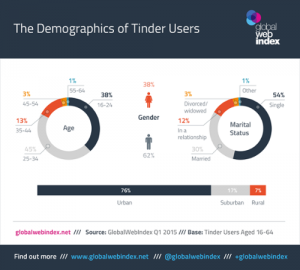Difference between revisions of "Tinder"
| Line 53: | Line 53: | ||
===Privacy=== | ===Privacy=== | ||
| − | With GPS-enabled tracking location, there is a high possibility for dating applications like Tinder to have privacy breaches. In July 2013, [[Wikipedia: Quartz_(publication)|Quartz]] found that Tinder revealed users’ exact longitude and latitude and Facebook ID and Tinder did not fix the issue until 2 weeks later.<ref>[http://qz.com/107739/tinders-privacy-breach-lasted-much-longer-than-the-company-claimed/ Quartz 'Tinder's Privacy Breach Lasted Much Longer than the Company Claimed']</ref> | + | With GPS-enabled tracking location, there is a high possibility for dating applications like Tinder to have privacy breaches. In July 2013, [[Wikipedia: Quartz_(publication)|Quartz]] found that Tinder revealed users’ exact longitude and latitude and Facebook ID and Tinder did not fix the issue until 2 weeks later.<ref>[http://qz.com/107739/tinders-privacy-breach-lasted-much-longer-than-the-company-claimed/ Quartz 'Tinder's Privacy Breach Lasted Much Longer than the Company Claimed']</ref> Users were not notified of this breach. In November 2013, Quartz found another privacy hole in Tinder where the API design is flawed and a user can fool Tinder into thinking she matches with someone who did not express interest and find that user’s email address.<ref>[http://qz.com/150839/dating-app-tinder-is-still-exposing-personal-information/ Quartz 'Dating App Tinder is Still Exposing Personal Information']</ref> |
| − | + | ||
Furthermore, mobile applications collect very sensitive information compared to web-based dating services and security measures on sites like Tinder are more robust. Even when Tinder does not show the actual location of the user but rather the distance to other users, malicious users can find the packets to recover the user’s actual location.<ref>[http://link.springer.com/chapter/10.1007/978-3-319-25744-0_13 Analysis of Privacy and Security Exposure in Mobile Dating Applications]</ref> Internet researchers stated that Tinder users give such detailed information “mileage to 15 decimal places that would allow any hacker with rudimentary skills to pinpoint a user’s location to within 100 feet”.<ref>[http://www.bloomberg.com/bw/articles/2014-02-19/new-tinder-security-flaw-exposed-users-exact-locations-for-months New Tinder Security Flaw Exposed Users' Exact Locations for Months]</ref> Privacy holes like above brings up the moral ethics of mobile dating applications. As much as Tinder promises to protect the information of its users, the Facebook tokens used brings a big privacy risk to users.<ref>[http://arxiv.org/pdf/1505.02906v1.pdf Privacy Risks in Mobile Dating Apps]</ref> | Furthermore, mobile applications collect very sensitive information compared to web-based dating services and security measures on sites like Tinder are more robust. Even when Tinder does not show the actual location of the user but rather the distance to other users, malicious users can find the packets to recover the user’s actual location.<ref>[http://link.springer.com/chapter/10.1007/978-3-319-25744-0_13 Analysis of Privacy and Security Exposure in Mobile Dating Applications]</ref> Internet researchers stated that Tinder users give such detailed information “mileage to 15 decimal places that would allow any hacker with rudimentary skills to pinpoint a user’s location to within 100 feet”.<ref>[http://www.bloomberg.com/bw/articles/2014-02-19/new-tinder-security-flaw-exposed-users-exact-locations-for-months New Tinder Security Flaw Exposed Users' Exact Locations for Months]</ref> Privacy holes like above brings up the moral ethics of mobile dating applications. As much as Tinder promises to protect the information of its users, the Facebook tokens used brings a big privacy risk to users.<ref>[http://arxiv.org/pdf/1505.02906v1.pdf Privacy Risks in Mobile Dating Apps]</ref> | ||
Revision as of 21:14, 22 February 2016
|
Tinder is a mobile dating application that allows users to meet others based on physical attraction. Users swipe right if they like the person or swipe left if they do not. A match is made when two users both swipe right on each other. Tinder is popular on college campuses, where students use the dating service for many possible reasons. It has been known to be a hook-up application, but due to Tinder’s simplicity, users also use it for downtime fun, to make new friends, or to find their future partner.
Contents
History
Sean Rad, Justin Mateen, and Jonathan Badeen are the founders of Tinder. Sean and Justin both grew up in Los Angeles and knew of each other since they both went to private high school together. However, they did not become close until math class freshman year at USC in Fall 2004.[1]
In 2009, Sean launched Adly, a celebrity social advertising platform where users create campaigns.[2] He shortly sold the company in Fall 2011 due to a decrease of interest in dealing with celebrities and advertisers. Sean then joined an incubator called Hatch Labs, funded by IAC and Xtreme Labs (Hatch Labs was later shut down in 2013).[3] There Sean met Jonathan Badeen, and the three of them came up with the idea of Tinder. This dating application mimics another application called Hot or Not, a rating site where users rate the attractiveness of the person in the photograph on a scale of 1-10.[4]
Tinder was seeded on a few college campuses and later spread to more due to the traction and attention it got from college students. The dating application started off with a user base majority made up of 18-24 years old and has now expanded widely to other age groups, where 45% of users are between 25 – 34 years old.[5]
Tinder was released on September 12, 2012. As of March 2015, there are 196 countries who use Tinder, roughly 50 million users, and 26 million matches made daily.[6]
How Tinder Works
Tinder is a free dating service application available for download on Android and iOS.
In order to use Tinder, the application first asks for the user’s permission to access her Facebook to retrieve simple information such as the user’s name, age, photos, and interests. The application also looks up on Facebook who the user’s mutual friends are and matches the user with friends of her mutual friends. This information is then used to create the user’s Tinder profile.
The user can then adjust the settings to her preference of gender, what age group she wants to be paired with, and how far the user is willing to travel to meet other Tinder users.
The user then sees a picture of a person on her screen with the simple information and short description about that person. If the user likes the person that she sees on the screen, she can swipe right or click on the green heart. If not, she can swipe left or click on the red cross. If the person she likes ends up liking her back, she will get notified that a match has been made and she can then message that person.[7]
Controversies
Due to the widespread usage of Tinder, the dating service application has received mixed reviews.
On August 2015, Vanity Fair released an article called “Tinder and the Dawn of the ‘Dating Apocalypse’”, which blames Tinder and other dating applications for the upbringing of the hookup culture. The article states that due to the large selection of men and women on the site, people are forgetting the meaning of real relationships and rather just value each other as sexual objects. Women are getting their hearts broken while men are enjoying the freedom of ‘no strings attached’. One guy Vanity Fair interviewed said, “you could talk to two or three girls at a bar and pick the best one, or you can swipe a couple hundred people a day – the sample size is much larger…two or three Tinder dates a week can rack up 100 girls you’ve slept with in a year”.[8]
Tinder fired back on Twitter stating that they are unfairly portrayed. Those that are looking to hook-up make up a small population of Tinder and is not representative of the whole. Tinder further states that “they create experiences and connections that otherwise never would have been made”, that their site brings more users together for serious relationships and marriages.[9]
Mel Robbins, a CNN commentator, believes that online dating applications such as Tinder have not fundamentally changed human behavior. She states that casual sex has always been prevalent in our culture, and “these apps just make it available to the masses”.[10] Men and women both have different views on relationships so communication should be established from the start. Men are found to use Tinder for easy hookups due to the wide accessibility to girls. Women who expect that casual hookups will turn into intimate relationships complain that it is hard to find a great guy who will commit easily on sites like Tinder.
Ethical Implications
Integrity
Since Tinder users are rated based on their personal appearance, pictures that they put up on their dating profile may not be exact representations of who they are in real life. DailyMail.com posted an article of Tinder users’ pictures to show the high contrast of people’s appearances online vs. offline.[11] In addition, hackers and malicious user with cyber-stalking intentions can create a fake Facebook with pictures of a stranger and say it is them on Tinder. With the lack of integrity, users who meet up with others on Tinder could end up in potential danger.
Privacy
With GPS-enabled tracking location, there is a high possibility for dating applications like Tinder to have privacy breaches. In July 2013, Quartz found that Tinder revealed users’ exact longitude and latitude and Facebook ID and Tinder did not fix the issue until 2 weeks later.[12] Users were not notified of this breach. In November 2013, Quartz found another privacy hole in Tinder where the API design is flawed and a user can fool Tinder into thinking she matches with someone who did not express interest and find that user’s email address.[13]
Furthermore, mobile applications collect very sensitive information compared to web-based dating services and security measures on sites like Tinder are more robust. Even when Tinder does not show the actual location of the user but rather the distance to other users, malicious users can find the packets to recover the user’s actual location.[14] Internet researchers stated that Tinder users give such detailed information “mileage to 15 decimal places that would allow any hacker with rudimentary skills to pinpoint a user’s location to within 100 feet”.[15] Privacy holes like above brings up the moral ethics of mobile dating applications. As much as Tinder promises to protect the information of its users, the Facebook tokens used brings a big privacy risk to users.[16]
References
- ↑ Inside Tinder: Meet the Guys Who Turned Dating Into An Addiction
- ↑ Adly - The Celebrity Social Advertising Platform
- ↑ Hatch Labs
- ↑ Hot or Not
- ↑ Wired - 42 Percent of Tinder Users Aren't Even Single
- ↑ DMR - By the Numbers: 37 Impressive Tinder Statistics
- ↑ What is Tinder: How does Tinder work?
- ↑ Tinder and the Dawn of the "Dating Apocalypse"
- ↑ The Guardian 'The Tinder Generation is real'
- ↑ CNN 'Has Tinder Replaced Dating with Hookup Culture?'
- ↑ Tinder vs. Reality
- ↑ Quartz 'Tinder's Privacy Breach Lasted Much Longer than the Company Claimed'
- ↑ Quartz 'Dating App Tinder is Still Exposing Personal Information'
- ↑ Analysis of Privacy and Security Exposure in Mobile Dating Applications
- ↑ New Tinder Security Flaw Exposed Users' Exact Locations for Months
- ↑ Privacy Risks in Mobile Dating Apps


